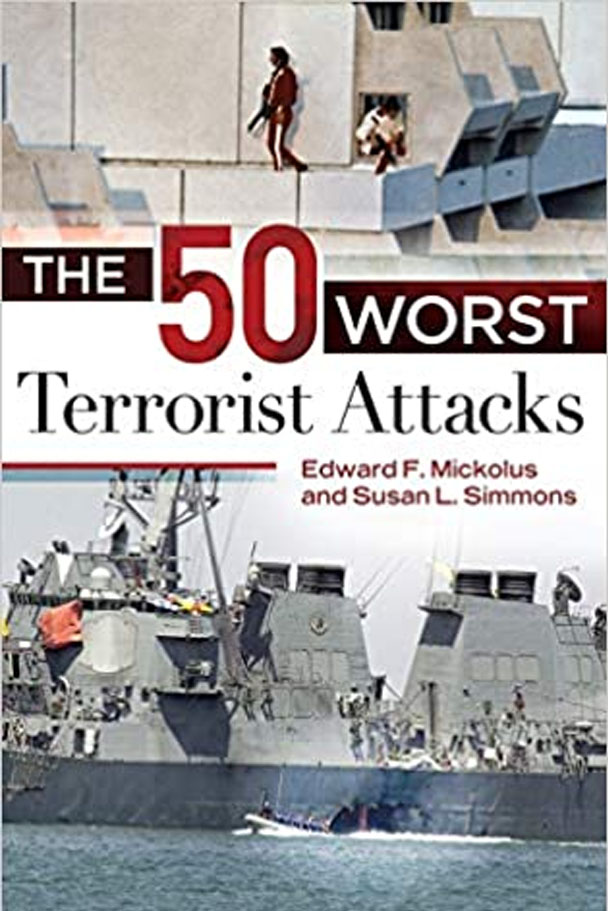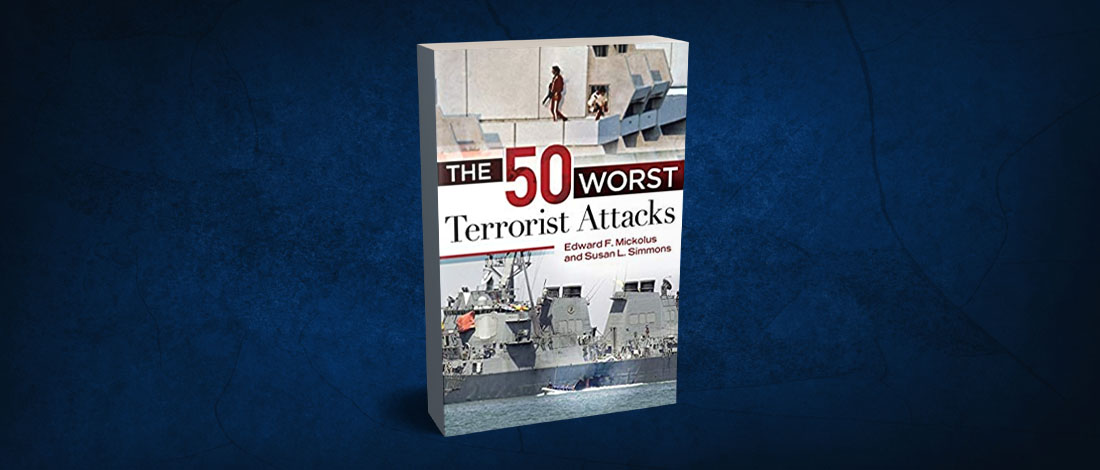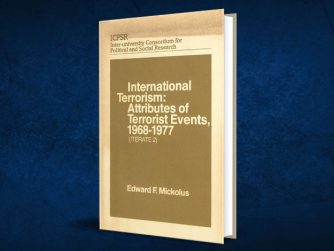Since the attacks on September 11, 2001, terrorism has remained the chief threat to international stability and security. The 50 Worst Terrorist Attacks draws on all forms of terrorism―international, transnational, and domestic―anywhere in the world, covering all types of acts (e.g., bombings, assassinations, armed attacks, skyjackings) by any organization and ideology.
The work goes beyond documenting the key events that occurred in or involved the United States; it also covers important terrorist attacks by left- and right-wing organizations, religiously motivated groups, and separatists that are largely unknown among Western audiences.
Each entry supplies the details of the attack―the perpetrators, victims, and eventual resolution―as well as the political, social, and international contexts in which the event occurred.
Readers will grasp the evolution of terrorist activities and methodologies in the 20th and 21st centuries, understand the importance of each event in the development of the terrorist repertoire, and gauge the responses intended to counter these new kinds of attacks.
- Title : The 50 Worst Terrorist Attacks
- Authors : Edward Mickolus, Susan Simmons
- Publisher : Praeger Security International
- Publication Date : August 11, 2014
- Language : English
- Hardcover : 264 pages
- ISBN-10 : 144082827X
- ISBN-13 : 978-1440828270
- Item Weight : 1.12 pounds
- Dimensions : 6.14 x 0.69 x 9.21 inches

Table of Contents
Introduction
Incidents
The 1960s
The 1970s
- March 31, 1970 Japanese United Red Army JAL hijacking to North Korea
- September 6, 1970 Dawson’s Field PFLP multiple aerial hijackings
- May 30, 1972 Japanese Red Army machine gun attack in Lod Airport
- September 5, 1972 Black September attack on Munich Olympics
- May 15, 1974 Maalot massacre
- December 21, 1975 Carlos and PFLP OPEC hostage-taking
- June 27, 1976 Entebbe
- October 6, 1976 Cubana Flight 455 bombed
- October 13, 1977 Landshut Hijacking and GSG9 rescue in Mogadishu
- March 16, 1978 Aldo Moro kidnapping
- August 27, 1979 Mountbatten assassination
- November 4, 1979 US Embassy Tehran takeover
- November 20, 1979 Mecca Grand Mosque takeover
The 1980s
- August 2, 1980 Bologna train bombing
- October 6, 1981 Egypt President Anwar Sadat assassination
- April 18, 1983 US Embassy Beirut bombing
- October 23, 1983 US Marine and French Paratrooper barracks in Lebanon bombed
- June 23, 1985 Air India flight bombed
- October 7, 1985 Achille Lauro seajacking
- April 5, 1986 Berlin La Belle Discotheque bombing
- September 5, 1986 Pan Am 73 hijacking
- December 21, 1988 Lockerbie bombing
- September 19, 1989 UTA bombing
The 1990s
- March 17, 1992 Buenos Aires Israeli Embassy bombing
- February 26, 1993 World Trade Center bombing
- July 18, 1994 AIMA Buenos Aires bombing
- March 20, 1995 Aum Shin Rikyo sarin gas attack on Tokyo subway
- April 19, 1995 Oklahoma City bombing
- June 14, 1995 Budennovsk, Russia hospital hostage-taking
- November 23, 1996 Ethiopian Airlines ET961 hijacked
- December 17, 1996 Japan Embassy in Peru takeover
- November 17, 1997 Luxor attack
- August 7, 1998 Tanzania and Kenya US Embassy bombings
- August 15, 1998 Omagh, Northern Ireland bombing
The 2000s
- October 12, 2000 Yemen USS Cole attack
- September 11, 2001 al Qaeda WTC, Pentagon, Pennsylvania hijackings
- October 12, 2002 Indonesia Bali bombings
- October 23, 2002 Moscow theater takeover
- May 12, 2003 Riyadh western housing complex bombings
- February 27, 2004 Philippines Superferry 14 bombed
- March 2, 2004 Baghdad and Karbala mosques attacked
- March 11, 2004 Madrid train bombings
- August 24, 2004 Chechens bomb two Russian planes
- September 1, 2004 Russia Beslan school takeover
- July 7, 2005 UK subway bombings
- July 23, 2005 Sharm el-Sheikh bombing
- July 11, 2006 India Mumbai train bombings
- November 26, 2008 India Mumbai attacks, 195 dead
The 2010s
- March 29, 2010 Russia Moscow subway bombings, 40 killed
- July 11, 2010 Uganda World Cup bombings 74 killed
- January 16, 2013AQIM Splinter Group Takeover of Algerian gas plant
Near Misses
- May 13, 1981 Attempted Papal assassination
- January 1995 Bojinka planned bombing of 10 US-bound planes
- December 15, 1999 planned Millennium bombing of Space Needle and airport
- December 22, 2001 The Shoe Bomber
- 2003 Mubtakkar CW attack on NYC subway
- August 10, 2006 planned liquid bombings of UK-to-US planes
- December 25, 2009 The Underwear Bomber
- May 1, 2010 Would-be bombing of Times Square
- October 29, 2010 AQAP printer toner cartridge bombs on planes
- February 17, 2012 Would-be suicide bomber at US Capitol
Missed the cut, but still noteworthy
- September 4, 1969 kidnapping of US Ambassador Burke Elbrick in Brazil
- March 1, 1973 Sudan US Ambassador Cleo Noel assassination
- December 27, 1974 FSLN Attack on US Ambassador Shelton party
- December 23, 1975 CIA Athens COS Richard Welch assassinated
- March 9, 1977 Hanafi takeover of Washington, DC buildings
- September 5, 1977 Baader-Meinhof kidnap/assassination of Hans-Martin Schleyer
- 1978-1995 Unabomber wave
- 1985-1986 wave of Lebanon kidnappings of Westerners
- January 25, 1993 Aimal Kasi attack at CIA Headquarters Route 123 entrance
- 2001 anthrax wave
- February 27, 2002–India Sabarmati Express train firebombed, 57 killed
- October 2004 Sinai Hilton Taba Hotel suicide bombing, 34 dead
- September 20, 2008 Islamabad Marriott Hotel bombing
- December 30, 2009 Afghanistan bombing of CIA Khost base
- October 31, 2010 Iraq Our Lady of Salvation Church takeover
- July 22, 2011 Breivik shooting and bombing spree in Oslo
Bibliography
Country and Date Index
Name Index
Introduction
During the last 50 years, the world has seen the rise of a particularly virulent threat to international order—terrorist attacks. While the theory and several methods of terrorism have long histories, arguably tracing to the Old Testament with the first political assassination, the use of terrorism by non-state actors on so grand a scale is a comparatively recent phenomenon. The authors have written several volumes chronicling the transnational form of terrorism, and are often asked which are the most important, worst, deadliest (insert your adjective here) terrorists and/or terrorist events of contemporary times. This volume attempts to answer those questions by listing the most important terrorist acts in history by year within each decade covered, including the incidents, the key actors involved, the victims, and government responses. Both domestic and international terrorist attacks are examined within security and political contexts to shed light on how the events unfolded.
This volume will use the definition of terrorism that we have found useful in our previous volumes. We consider terrorism to be the use or threat of use of violence by any individual or group for political purposes. The perpetrators may be functioning for or in opposition to established governmental authority. A key component of international terrorism is that its ramifications transcend national boundaries, and, in so doing, create an extended atmosphere of fear and anxiety. The effects of terrorism reach national and worldwide cultures as well as the lives of the people directly hurt by the terrorist acts. Violence becomes terrorism when the intention is to influence the attitudes and behavior of a target group beyond the immediate victims. Violence becomes terrorism when its location, the victims, or the mechanics of its resolution result in consequences and implications beyond the act or threat itself.
Unlike our previous volumes, we have also included several major domestic terrorist acts, whose effects essentially stayed within the borders of one country, also media coverage may have become regional or global. Listing only international attacks—which transcend local boundaries, again, because of changes in the location or the nationality of the victims, responders, perpetrators, of mechanics of incident resolution—can give a false sense of the extent of terrorism in a country and/or a period. Much the way incident counts as appear below can give a false sense of security or insecurity, so too would merely including international attacks give an inaccurate picture of the “worst”, however defined. In like manner, looks at trends in outliers—the Worst—can also skew our perceptions. Some have argued that post-9/11 is a new era in terrorism. While that may be true for the types of Worst events, overall, trends in “garden variety” attacks have continued throughout the five decades surveyed herein.

In addition to the definition of terrorism per se, we also need to consider what constitutes a “worst”. Simply tallying deaths, injuries, and property damage, while methodologically straightforward, is ultimately unsatisfying. Part of the definition of terrorism is that the perpetrators are seeking publicity; killing for killing’s sake (although certainly more popular in recent years amongst the jihadi culture) doesn’t quite fulfill our intuitive sense of “worst”. We thus have sought to include incidents that spilled ink and pixels as well as blood and treasure. As a sanity check, we have shared our 50 Worst list with numerous experts in the field of terrorism, as well as various worthies in other fields to ensure that the terrorists’ message did get through to others beyond the terrorism-watching set. Inherent to such a method, however, is a somewhat Western-centric bias—much of the major media outlets—at least, those that we used in putting together the list—are Western-based. One also tends to consider “worst” those incidents that are nearer to one’s own interests; an attack that injures you or kills one of your family, colleagues, and/or friends is for you the worst event possible, although it may vanish into the error term when compared with multiple-casualty spectaculars.
We have also included some incidents because they created a new technique, attacked a new type of target, crossed a moral, technological, or operational threshold, or otherwise added to the repertoire of terrorism in general. These “firsts” tended not to be as deadly as some of the incidents that did not make the cut, but are more historically important in the evolution of terrorism as a technique and security problem.
Our criteria for inclusion is limited to single events, or events that are so tied together—multiple hijackings or bombings on the same day—as to have been treated as a single incident. Thus the 1970 Dawson’s Field hijackings and the 9/11 attacks, although involving four separate hijack teams, nonetheless had the effect of a single operation. Serial attacks by a single perpetrator or unknown individuals, such as letterbombers sending scores of parcel bombs—such as the Unabomber’s 17-year campaign—or the Amerithrax attacks of October 2001, while cumulatively important, did not include a specific event that rises to the level of the others included in the 50 Worst. In the interests of comprehensiveness, however, we have included such events in a separate section. Similarly, we have included a separate discussion of incidents that were foiled before they could achieve the effects intended by the perpetrators—the “it could have been worse” event.
Although the 50 Worst are noteable for their deadliness, overall terrorist attacks—at least the 13,000+ international ones covered by our ITERATE dataset—rarely include casualties in the dozens, much less hundreds. As shown in the chart below, even the worst year of the half-century tallied just over 4,000 casualties. Given the potential threat inherent in CBRN (chemical, biological, radiological, and nuclear) and cyber attacks, terrorists have tended to keep their attacks under a certain deadly threshold.

Moreover, looking strictly at international attacks, Americans have tended to be disproportionately popular targets of terrorists, whether in garden-variety bombings and shootings or in the 50 Worst spectaculars. Some of the domestic attacks that rose to the level of 50 Worst, however, definitionally did not include Americans.

Expanding the years covered by our list to pre-1960 would include several incidents, some of which are proto-terrorist (the assassination of Abraham Lincoln by bitter-enders, the assassination of Archduke Ferdinand that sparked WWI, various assassinations of American Presidents and other foreign leaders) and various anarchist bombing campaigns, the bombing of the King David Hotel by Irgun, the Assassin cult that flourished from the 8th to the 14th centuries, would also merit consideration.
The 50 Worst list is, unfortunately, a living document, and we expect that the future will include attacks that will bump some of these attacks from the list.
We have seen several trends in the 50 Worst that reflect shifts in terrorist behavior in general over the past half-century. Among them has been a shift in the type of terrorist tactic(s) employed. Terrorism has generally been a battle between offense and defense. Once security forces determine methods to harden a likely target against a certain type of attack, terrorists have generally not thrown in the towel. Rather, they have innovated, constantly putting the burden on the defensive forces to keep up.
There has also been a changing of the guard between terrorist groups and individuals making the list. Although terrorism as a tactic probably cannot be completely eradicated—the existence of evil is part of the human condition—specific terrorist groups have been eliminated, through the aging of the principals, their deaths, imprisonment, or maturity beyond their radical youth, changing in political fortunes, ending of patron state support, government/private security methods becoming more effective, or other reasons.
We can see this evolution of Worst Group identities most clearly in a ranking of groups whose depredations appear in the 50 Worst list. Some groups—radical West European leftists, leftist Palestinians—enjoyed their heydays in the 1970s but then dropped off the list—as they did in more “normal” attacks. Most disturbingly, the religious-based Islamist radicals have shown greater staying power than their leftist forebears, most of whom have become extinct. For the moment, al Qaeda and its affiliates have established themselves as the single worst group of the half-century in terms of conducting the most spectaculars.
Exclusion of a group from this list does not mean that they were not active, nor a major threat, during this period. Groups such as the Abu Nidal/Black June Organization, the Basque Nation and Liberty, the Armenian Secret Army for the Liberation of Armenia, and scores of other groups conducted numerous attacks during this period. None of their attacks, however, rose to the level of a 50 Worst event.
Al Qaeda and offshoots
February 26, 1993 World Trade Center bombing
August 7, 1998 Tanzania and Kenya US Embassy bombings
October 12, 2000 Yemen USS Cole attack
September 11, 2001 al Qaeda WTC, Pentagon, Pennsylvania hijackings
October 12, 2002 Indonesia Bali bombings
May 12, 2003 Riyadh western housing complex bombings
March 2, 2004 Baghdad and Karbala mosques attacked
March 11, 2004 Madrid train bombings
July 7, 2005 UK subway bombings
July 11, 2010 Uganda World Cup bombings
January 16, 2013AQIM Splinter Group Takeover of Algerian gas plant
Popular Front for the Liberation of Palestine (PFLP) and offshoots
September 6, 1970 Dawson’s Field multiple aerial hijackings
December 21, 1975 Carlos-led OPEC hostage-taking
June 27, 1976 Entebbe
October 13, 1977 Landshut hijacking to Mogadishu
Hizballah
April 18, 1983 US Embassy Beirut bombing
October 23, 1983 US Marine and French Paratrooper barracks in Lebanon bombed
March 17, 1992 Buenos Aires Israeli Embassy bombing
July 18, 1994 AIMA Buenos Aires bombing
Chechens
June 14, 1995 Budennovsk, Russia hospital hostage-taking
October 23, 2002 Moscow theater takeover
August 24, 2004 Chechens bomb two Russian planes
September 1, 2004 Russia Beslan school takeover
March 29, 2010 Russia Moscow subway bombings
Black September
September 5, 1972 Black September attack on Munich Olympics
European Leftists: Baader-Meinhof, Red Brigades
June 27, 1976 Entebbe
October 13, 1977 Landshut hijacking to Mogadishu
March 16, 1978 Aldo Moro kidnapping
Latin American Leftists
December 17, 1996 Japan Embassy in Peru takeover
Irish Republican Army
August 27, 1979 Mountbatten assassination
August 15, 1998 Omagh, Northern Ireland bombing
JRA and URA
March 31, 1970 Yodo hijacking to DPRK
May 30, 1972 Japanese Red Army machine gun attack in Lod Airport
Indian nationalists, leftists, separatists
June 23, 1985 Air India flight bombed
July 11, 2006 India Mumbai train bombings
Other Palestinian groups
May 15, 1974 Maalot massacre
October 7, 1985 Achille Lauro seajacking
April 5, 1986 Berlin La Belle Discotheque bombing
September 5, 1986 Pan Am 73 hijacking
December 21, 1988 Lockerbie bombing
September 19, 1989 UTA bombing
Other Islamists
October 6, 1981 Egypt President Anwar Sadat assassination
November 17, 1997 Luxor attack
July 23, 2005 Sharm el-Sheikh bombing
November 26, 2008 India Mumbai attacks
To provide context for the environments in which these attacks took place, we will provide discussions of each of the decades covered in this book.







